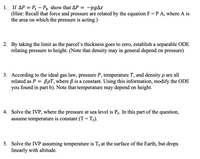Question
I need to know how to solve this ODE IVP set

Transcribed Image Text:Consider a thin parcel of air at an arbitrary height z in the atmosphere (z= 0 corresponds to
sea-level). It has thickness Az, cross-sectional area A, and mass density p. Assume gravity (g)
is constant, and there is no wind, so the parcel is neither rising nor falling.
There are three relevant forces:
The upward force F, acting on the bottom of the parcel. This is caused by air
from below.
pressure Pp
- The downward force F, acting on the top of the parcel. This is caused by air pressure P;
from above.
The weight force of the parcel itself, due to gravity.
Fi
Az
F9

Transcribed Image Text:1. If AP = Pt – P, show that AP = -pgAz
(Hint: Recall that force and pressure are related by the equation F=P A, where A is
the area on which the pressure is acting.)
2. By taking the limit as the parcel's thickness goes to zero, establish a separable ODE
relating pressure to height. (Note that density may in general depend on pressure)
3. According to the ideal gas law, pressure P, temperature T, and density p are all
related as P = BpT, where B is a constant. Using this information, modify the ODE
you found in part b). Note that temperature may depend on height.
4. Solve the IVP, where the pressure at sea level is Po. In this part of the question,
assume temperature is constant (T= To).
5. Solve the IVP assuming temperature is To at the surface of the Earth, but drops
linearly with altitude.
Expert Solution
This question has been solved!
Explore an expertly crafted, step-by-step solution for a thorough understanding of key concepts.
Step by stepSolved in 2 steps

Knowledge Booster
Similar questions
- can u explane ı cant solvearrow_forwardThe inhomogeneous Maxwell equations are given as follows: 18 c² Ət V.E= (b) P Eo VxB - Use inhomogeneous Maxwell equations to derive the two equations of motion for the potentials (a) -0$ 10 -DA+VV.A+ Φ = HoJ, c² Ət Ε= μου. P - (v. A+ 100) - ². ә Ət = t Hint: Vx (V xA) = V(VA) - V²A and =V²- -arrow_forward(2).What is the range of vehicle speeds kinematically possible to achieve in pure electric mode?arrow_forward
- The intensity I of radiation after passing a distance x through a shield, falls off according to the expression I = 2.718,, (approximately.) 1o er where 1o and l are constants, ande The variable Z In I should be in x exponential logarithmic O linear quadraticarrow_forward(1) Derive the Maxwell's relations ƏT as, S V Əs \ƏT. T V G), = - aT Tarrow_forward
arrow_back_ios
arrow_forward_ios